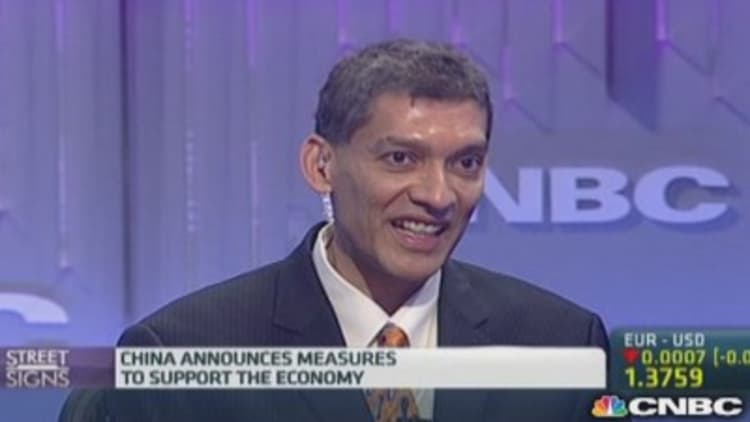
China's latest stimulus package designed to boost spending on railways and other infrastructure projects has raised the question of whether Beijing is resorting to its old ways.
Beijing late on Wednesday acted to arrest a slowdown in the world's second largest economy by announcing plans to accelerate spending on railways, upgrade housing for low-income households and lower tax rates for smaller companies.
In contrast to previous stimulus programs, economists say the new round of stimulus is deliberately targeted to complement the government's reform agenda including improving the livelihood of its citizens and establishing a long-term sustainable funding channel for infrastructure projects.
(Read more: China takes first step to steady economic growth)
"This is not quite a repeat of previous occasions when China stimulated growth," Qu Hongbin and Sun Junwei, economists at HSBC wrote in a report on Thursday.
"The scale of the stimulus is modest, likely aimed at smoothing gross domestic product (GDP) growth at around the 7.5 percent target, rather than another round of massive stimulus. This should buy time to implement reform measures, which could involve some short-term pain," they said.
(Read more: China takes first step to steady economic growth)
While the package's focus on infrastructure may contradict Beijing's push to rebalance the economy from an investment-driven to consumption-led economy, economists say investment in expanding the rail network in the inland provinces and shantytown reconstruction are much needed in the country's development.
China has launched a slew of stimulus packages to bolster the economy over the recent years, the largest being the 4 trillion yuan package delivered in 2008-2009, post Lehman's collapse, to fight the country's downturn.
Since then, the government has rolled out smaller packages to prop up growth in 2012 and 2013. The measures announced last year were largely aimed at boosting business activity through measures such as tax breaks for small companies and reducing administrative costs for exporting companies.
(Read more: China's shadow lenders: Here's how one is thriving)
Economists say the main reform element of the new stimulus package is the way the infrastructure projects are funded.
Unlike in the past where fiscal stimulus was largely funded through borrowing by local governments, the central government is looking to fund infrastructure investment through more sustainable means.
To fund railway investment, the government will set up a railway development fund aiming to reach 200-300 billion yuan per year and introduce new railway construction bonds. And, for rebuilding urban shantytowns, Beijing has called on the China Development Bank (CDB), the largest policy bank in the country, to sell bonds to finance these projects.
"As we have argued many times, China should deleverage its local governments while leveraging up the central government to deliver growth soft landing while defusing its debt problem. One important approach is to raise the government's policy banks' role in infrastructure and social housing investment," said Ting Lu, chief China economist at Bank of America Merrill Lynch. "Now we finally got it."
"These measures show that Premier Li's government aims to stabilize short-term growth with policies which can enhance efficiency while avoiding future financial troubles," Lu said.
With the new stimulus expected to put a floor under China's growth, economists say this has reduced the possibility of monetary stimulus.
"If things deteriorate substantially, then all options are on the table, but for now, this lessens the likelihood of monetary accommodation," said Tim Condon, head of research, Asia at ING.
For now, the People's Bank of China (PBoC) will continue to keep a close eye on M2 - a measure of money supply - and interbank rates to make sure there is enough liquidity to support growth, say economists.


